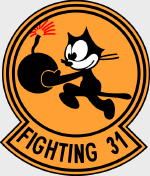Hobby Master HA5106 US Navy Boeing F/A-18E Super Hornet Strike Fighter - 166776, VFA-31 "Tomcatters", CAG, USS Theodore Roosevelt (CVN-71), 2009 (1:72 Scale)
"We Get Ours at Night"
- Motto of VFA-31
 The Boeing F/A-18E and F/A-18F Super Hornet are twin-engine carrier-capable multirole fighter aircraft variants based on the McDonnell Douglas F/A-18 Hornet. The F/A-18E single-seat and F/A-18F tandem-seat variants are larger and more advanced derivatives of the F/A-18C and D Hornet. The Super Hornet has an internal 20 mm M61 rotary cannon and can carry air-to-air missiles and air-to-surface weapons. Additional fuel can be carried in up to five external fuel tanks and the aircraft can be configured as an airborne tanker by adding an external air refueling system.
The Boeing F/A-18E and F/A-18F Super Hornet are twin-engine carrier-capable multirole fighter aircraft variants based on the McDonnell Douglas F/A-18 Hornet. The F/A-18E single-seat and F/A-18F tandem-seat variants are larger and more advanced derivatives of the F/A-18C and D Hornet. The Super Hornet has an internal 20 mm M61 rotary cannon and can carry air-to-air missiles and air-to-surface weapons. Additional fuel can be carried in up to five external fuel tanks and the aircraft can be configured as an airborne tanker by adding an external air refueling system.
Designed and initially produced by McDonnell Douglas, the Super Hornet first flew in 1995. Full-rate production began in September 1997, after the merger of McDonnell Douglas and Boeing the previous month. The Super Hornet entered service with the United States Navy in 1999, replacing the Grumman F-14 Tomcat, which was retired in 2006; the Super Hornet serves alongside the original Hornet. The Royal Australian Air Force (RAAF), which has operated the F/A-18A as its main fighter since 1984, ordered the F/A-18F in 2007 to replace its aging F-111C fleet. RAAF Super Hornets entered service in December 2010.
Pictured here is a gorgeous 1:72 scale diecast replica of a US Navy Boeing F/A-18E Super Hornet strike fighter assigned to the CAG of VFA-31 "Tomcatters", then embarked upon the USS Theodore Roosevelt (CVN-71) during 2009.
Sold Out!
Dimensions:
Wingspan: 7-1/2-inches
Length: 9-inches
Release Date: May 2018
 Historical Account: "Rhino" - The Hornet and Super Hornet share many characteristics, including avionics, ejection seats, radar, armament, mission computer software, and maintenance/operating procedures. The Super Hornet is largely a new aircraft at about 20% larger, 7,000 lb (3,200 kg) heavier empty weight, and 15,000 lb (6,800 kg) heavier maximum weight than the original Hornet. The Super Hornet carries 33% more internal fuel, increasing mission range by 41% and endurance by 50% over the "Legacy" Hornet. The empty weight of the Super Hornet is about 11,000 lb (5,000 kg) less than that of the F-14 Tomcat which it replaced, while approaching, but not matching, the F-14's payload and range. As the Super Hornet is significantly heavier than the "legacy" Hornet, the catapult and arresting systems must be set differently. To aid safe flight operations and prevent confusion in radio calls, the Super Hornet is informally referred to as the "Rhino" to distinguish it from earlier Hornets. (The "Rhino" nickname was previously applied to the McDonnell Douglas F-4 Phantom II, which was retired from the fleet in 1987.)
Historical Account: "Rhino" - The Hornet and Super Hornet share many characteristics, including avionics, ejection seats, radar, armament, mission computer software, and maintenance/operating procedures. The Super Hornet is largely a new aircraft at about 20% larger, 7,000 lb (3,200 kg) heavier empty weight, and 15,000 lb (6,800 kg) heavier maximum weight than the original Hornet. The Super Hornet carries 33% more internal fuel, increasing mission range by 41% and endurance by 50% over the "Legacy" Hornet. The empty weight of the Super Hornet is about 11,000 lb (5,000 kg) less than that of the F-14 Tomcat which it replaced, while approaching, but not matching, the F-14's payload and range. As the Super Hornet is significantly heavier than the "legacy" Hornet, the catapult and arresting systems must be set differently. To aid safe flight operations and prevent confusion in radio calls, the Super Hornet is informally referred to as the "Rhino" to distinguish it from earlier Hornets. (The "Rhino" nickname was previously applied to the McDonnell Douglas F-4 Phantom II, which was retired from the fleet in 1987.)









